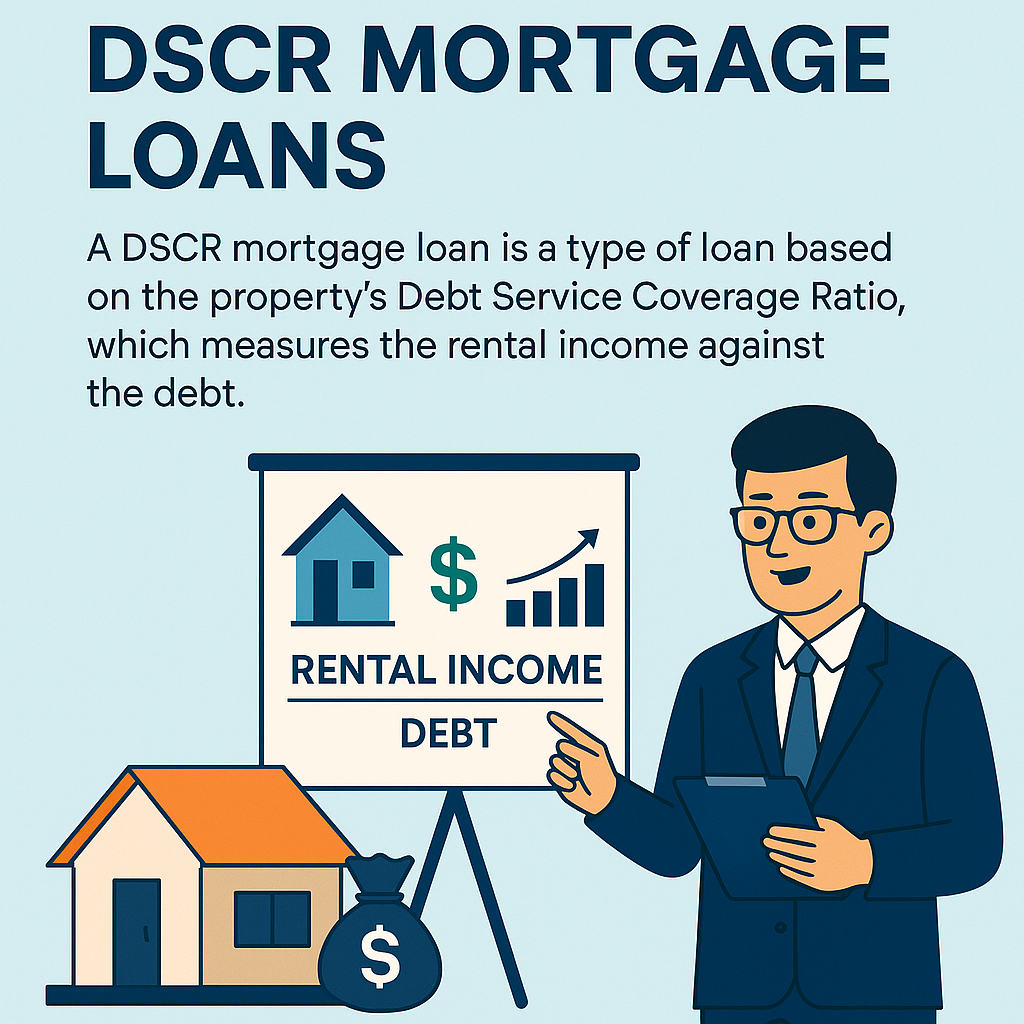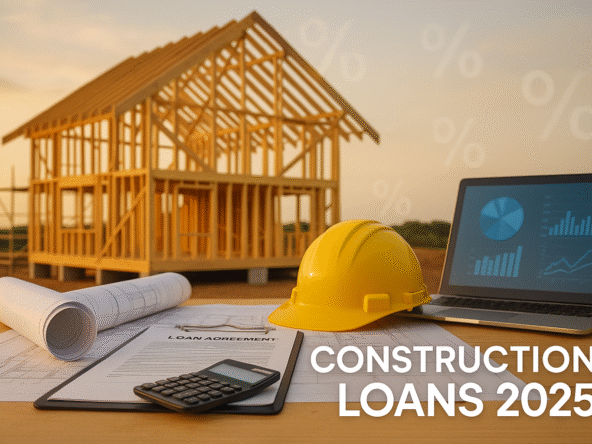Investing in real estate can be challenging for beginners, especially when it comes to financing. One popular financing option for new investors is the DSCR loan – a type of real estate investor loan that uses a property’s cash flow to help you qualify. DSCR stands for Debt Service Coverage Ratio, a key metric that lenders use to evaluate investment property loans. In this beginner-friendly guide, we’ll explain what DSCR means, how a DSCR mortgage works, and how to qualify for a DSCR loan. We’ll also highlight the benefits for first-time investors, provide an example debt service coverage ratio mortgage calculation, compare DSCR loans vs. traditional loans in a handy table, and address common questions. By the end, you’ll understand why DSCR loans are often considered an ideal real estate investor loan for beginners and how to get started.
What is DSCR (Debt Service Coverage Ratio)?
Debt Service Coverage Ratio (DSCR) is a financial ratio that measures a property’s income relative to its debt payments. In real estate, DSCR helps determine if a rental property’s cash flow can cover the mortgage. It’s calculated by dividing the property’s income by its debt obligations. For a rental property, that typically means dividing the annual or monthly rental income by the annual or monthly mortgage payment (principal, interest, taxes, insurance, and any HOA fees)easystreetcap.com.
For example, if a property generates $5,000 in rent each month and the monthly mortgage (PITI + HOA) is $4,000, the DSCR = $5,000 ÷ $4,000 = 1.25homelifemtg.com. A DSCR of 1.0 is breakeven (the property’s income exactly covers the debt), above 1.0 means the property produces surplus cash flow, and below 1.0 means it isn’t generating enough to fully cover its debteasystreetcap.com. Lenders view a higher DSCR as a sign of lower risk – for instance, a DSCR of 1.25 indicates the property income is 25% greater than the mortgage payments, a healthy cushion. On the other hand, a DSCR below 1.0 would signal negative cash flow (the property’s income falls short of the debt obligations)griffinfunding.com.
What is a DSCR Mortgage Loan and How Does It Work?
A DSCR mortgage loan is a type of mortgage designed for real estate investors that allows you to qualify based on a property’s cash flow instead of your personal incomeeasystreetcap.commovement.com. In a traditional mortgage, lenders scrutinize your employment, W-2s, tax returns, and calculate your debt-to-income (DTI) ratio to decide if you qualify. By contrast, a DSCR loan (also called a debt service coverage ratio loan) focuses on the property’s rental income and DSCR to determine if the loan is viableeasystreetcap.com. Essentially, the property’s ability to pay for its own mortgage is the key factor.
With a DSCR loan, no personal income verification is required – you typically don’t need to provide W-2 forms, pay stubs, or tax returns to prove your incomeeasystreetcap.commovement.com. The lender will look at the expected rental income of the investment property (using either current lease agreements or market rent estimates) and ensure it is enough to cover the mortgage payments. If the property’s DSCR meets the lender’s minimum requirement, and you meet a few other criteria (like credit score and down payment), you can qualify purely based on the property’s cash flow. This makes DSCR loans a form of “no-income verification” mortgage for investors, sometimes called a cash-flow mortgage, because the deal is underwritten primarily on the income potential of the property rather than the borrower’s wageseasystreetcap.com.
It’s important to note that DSCR loans are for business purposes only – they cannot be used for an owner-occupied home. You must be buying or refinancing a non-owner-occupied property that will generate rental income (such as a single-family rental, condo, or 2-4 unit multifamily)griffinfunding.com. In other words, you cannot use a DSCR loan to buy your primary residence or a second home; they are intended strictly for investment properties. The property should ideally be in rent-ready condition (turnkey), because lenders are counting on its immediate income. Some DSCR lenders even allow loans on short-term rental properties or commercial multifamily, but the common theme is that the property must produce income to support the loan.
How does a DSCR loan work in practice? When you apply, the lender will order an appraisal with a rent analysis to determine the market rental value. They will then calculate the DSCR by comparing that rental income to the projected mortgage payment on the loan amount you’re seeking. If, for example, the rent is equal to the mortgage payment (DSCR = 1.0), some lenders will consider that the minimum needed to approve the loan. Many lenders, however, prefer a little cushion – often requiring a DSCR of around 1.1 to 1.25 or higher for approvalnewsilver.comthefederalsavingsbank.com. The higher the DSCR, the better your chances of approval and even securing a favorable interest rate, since a strong DSCR indicates the property can comfortably cover the debtnewsilver.com. On the flip side, if the DSCR is too low (meaning the property’s income isn’t sufficient), the lender might ask for a larger down payment, require interest-only payments to boost cash flow, or even deny the loan until you improve the numbers.
Benefits of DSCR Loans for Beginner Investors
DSCR loans offer several advantages for first-time and beginner real estate investors:
- Easier Qualification (No DTI hurdles): The biggest benefit is that you don’t need traditional income documents or a low personal debt-to-income ratio to qualify. Even if you’re self-employed, newly in business, or don’t have a high salaried income, you can still get a DSCR loan as long as the property itself is a good performermovement.commovement.com. This opens the door for many beginners who might not qualify for a conventional loan due to strict income or employment history requirements. Essentially, the property’s income “qualifies” for you.
- Streamlined and Faster Approval: Because the focus is on the property’s cash flow, the approval process can be faster and more streamlined than a conventional mortgage. There is less paperwork about your personal finances – lenders primarily evaluate the deal’s numbers (rent, expenses, property value) plus your credit and assetsmovement.com. This often means fewer hoops to jump through and quicker closing times. Some DSCR loan providers advertise faster closings since there’s no need for income underwriting or exhaustive verification.
- Portfolio Growth and Scaling: DSCR loans are ideal for investors looking to grow a rental portfolio over time. With conventional financing, each new mortgage increases your personal debt load and can be limited by your DTI or a cap on number of mortgages (for example, Fannie Mae guidelines limit most borrowers to 10 financed properties). DSCR loans, however, assess each property’s loan on its own merits. As long as each property’s cash flow is strong, you can keep financing additional properties without being personally capped outmovement.com. This flexibility lets beginners start with one rental and keep building. Your ability to get more loans isn’t tied directly to your personal income or total debt – it’s tied to finding deals that cash flow.
- No Limit on Number of Properties: Related to scaling, many DSCR lenders do not impose strict limits on how many properties or DSCR loans you can have. Since these are business-purpose loans, a lender might finance multiple properties for you concurrently, provided each meets the DSCR criteria and you have the required down payments. This makes DSCR financing a powerful tool to accelerate an investing career, even for a newbie investor with ambitions to acquire several rentals.
- Flexibility in Loan Terms: DSCR mortgages often come with flexible options that can benefit investors’ cash flow. For example, interest-only payment periods are common, where you pay only interest (no principal) for the first 5 or 10 years. This keeps the monthly payment low initially, which boosts the DSCR ratio and can make it easier to qualify and profit in the early yearseasystreetcap.com. Also, DSCR loans are typically available as 30-year fixed loans (often with no balloon payments) or adjustable rates, giving you choices similar to traditional mortgages but tailored to investment needs. Some lenders even offer 40-year terms or other creative structures to maximize cash flow.
- Accepts Non-Traditional Situations: For a beginner investor, life isn’t always cookie-cutter – you might be self-employed, using gift money for a down payment, or buying a property that’s currently vacant. DSCR loans can handle these scenarios. Many programs allow 100% gift funds for the down payment and closing costs (meaning you could use gifted money to finance your first deal)homelifemtg.com. If the property is vacant (no current tenant), lenders simply use the appraiser’s market rent estimate to calculate DSCR, so you can still qualify even without a signed lease in placehomelifemtg.com. DSCR loans also welcome investors who partner with others or those buying in an LLC, since personal income isn’t a factor. This flexibility is a huge plus for new investors who might not fit the strict mold of conventional loan criteria.
- Focus on Investment Quality: A subtle benefit is that DSCR loans encourage you to choose properties that are good investments. Since approval depends on the property’s income covering the debt, you’re inherently steered toward deals that cash flow. For a beginner, this focus can be helpful – it emphasizes proper due diligence on rental income and expenses. If a property’s projected DSCR is too low, that’s a signal it might not be a great deal (unless you have a plan to improve its income or value). In short, the DSCR loan model rewards properties that make financial sense, which can align a new investor’s goals with the lender’s criteria.
Of course, DSCR loans also come with some trade-offs (which we’ll discuss in the comparison section), but the above benefits make them a game-changer for many first-time investorsmovement.com looking for real estate investor loans that are more accessible.
How to Qualify for a DSCR Loan (Qualification Requirements)
Qualifying for a DSCR mortgage loan is straightforward compared to a traditional loan, but you still need to meet certain requirements. Here are the typical qualification criteria for DSCR loans:
- Debt Service Coverage Ratio: The property must meet the lender’s minimum DSCR. Most lenders require a DSCR of around 1.1 to 1.25 or higher to approve the loannewsilver.com. In practice, a DSCR of 1.20+ is considered solid, and 1.25 or above is often viewed as “good”thefederalsavingsbank.com. Some lenders may accept a DSCR of 1.0 (breakeven) or even below 1.0 in special cases, but expect stricter terms (higher rates or more down payment) if sogriffinfunding.com. As a beginner, aiming for a property with DSCR ≥ 1.2 is a good rule of thumb.
- Down Payment / Loan-to-Value: You’ll need a significant down payment. DSCR loans typically max out at 75-80% LTV, meaning a 20-25% down payment is standardnewsilver.com. For example, on a $200,000 rental property you should be prepared to put down $40,000–$50,000. Some programs may allow slightly lower down payments for very strong deals, but generally the larger your down payment, the easier it is to qualify (a lower LTV improves the DSCR and lowers the lender’s risk). Many first-time DSCR borrowers put down 25% to strengthen their application.loanguys.com
- Credit Score: Even though income isn’t scrutinized, credit score matters. Most DSCR lenders want to see a minimum credit score around 620–680. A common benchmark is 660+ FICO as a minimum, though some lenders will go down to 620griffinfunding.comnewsilver.com. Keep in mind that a higher credit score can get you better rates and terms. For instance, to borrow at the maximum 80% LTV, a lender might require a 700+ credit scorenewsilver.com. As a new investor, it’s wise to check your credit and try to have it in the mid-600s or above before applying for a DSCR loan.
- Property Type and Condition: The loan must be for an investment property that you will not occupy. Eligible properties commonly include single-family homes, condos, townhomes, and 2-4 unit residential properties that will be rented out. Many lenders also finance multifamily (5+ units) or commercial residential properties with DSCR loansnewsilver.com, although as a beginner you’ll likely start with 1-4 units. The property usually needs to be in habitable, rent-ready condition (since the lender is counting on rental income). Fixer-uppers that aren’t producing income may not qualify until repaired, unless you use a different loan (like a rehab loan) then refinance into a DSCR loan once the property is rentable.
- Appraisal with Rental Analysis: As part of the process, an appraisal will be done including a rent survey (often called a 1007 rent schedule). The appraiser will determine the market rent for the property. Lenders will use the lower of the market rent or actual lease rent (if there’s already a tenant) to calculate DSCReasystreetcap.com. This means if you plan to charge, say, $2,000/month but the appraiser finds market rent is $1,800, the lender will use $1,800 in the DSCR formula. Be aware of this when selecting properties – your deal should make sense at market rent, not an inflated projection.
- Reserves: Many DSCR loan programs require you to have some cash reserves on hand after the down payment and closing costs. Reserves are typically measured in months of mortgage payments. For example, a lender might require 6 months of PITI payments in reserve for a DSCR loan, though some lenders have no reserve requirement if the DSCR is strong (≥1.0)homelifemtg.com. As a newbie, expect to show a few months’ worth of payments as a safety net – having additional savings will boost lender confidence.
- Other Common Requirements: You will need to form a business entity (LLC) in some cases, since DSCR loans are for business purpose (some lenders let you close in your personal name, but many encourage or require an LLC for the property title). You’ll also sign documents attesting that you will not occupy the home. Prepayment penalties are common on DSCR loans (more on that below), so be prepared to keep the loan for a few years or pay a fee if you refinance/sell early. Lastly, while not a formal requirement, an experienced property manager or plan to manage the property can be a plus – it’s important to successfully rent out the property to achieve the projected income.
In summary, to qualify for a DSCR loan as a beginner you should have decent credit (around 660+), a 20-25% down payment, and a property with strong rental income that meets a ~1.2 DSCR or betterloanguys.com. If these boxes are checked, you stand a great chance of approval because the lender will see that the deal “pencils out.” Compared to a conventional loan, you won’t need to prove your personal income or job — the property’s income potential carries the weight in the approval decisionloanguys.com.
DSCR Loan Calculation Example
Understanding the DSCR calculation is crucial for investors. Let’s walk through a simple example of how a DSCR loan is evaluated:
Scenario: You’re purchasing a rental duplex. Each unit rents for $1,000 per month, so the total monthly rental income is $2,000. That equals $24,000 per year in gross rent. After a 25% down payment, you anticipate a monthly mortgage PITI (principal, interest, taxes, insurance) of $1,600. There are no HOA dues.
- Annual Rental Income: $2,000 × 12 = $24,000
- Annual Debt (PITI): $1,600 × 12 = $19,200
Using the DSCR formula: DSCR = Annual Rental Income ÷ Annual Debt. In this case:
DSCR=$24,000$19,200≈1.25.DSCR = \frac{\$24,000}{\$19,200} \approx 1.25.DSCR=$19,200$24,000≈1.25.
The property’s DSCR is 1.25, meaning the rental income is 125% of the mortgage costs. This 1.25 DSCR would generally be considered a strong DSCR that indicates positive cash flowhomelifemtg.com. Because the property can cover the debt service with a 25% cushion, a lender would likely view this deal favorably. With a DSCR of 1.25, you’d typically qualify for a DSCR loan (assuming credit and other factors check out) and possibly even get a better interest rate than if the DSCR were lowergriffinfunding.com.
Now, if those numbers were reversed – say the rent was only $1,500 and the mortgage still $1,600 – the DSCR would be 0.94 (i.e. $18,000 / $19,200). A DSCR below 1.0 indicates the property doesn’t quite cover its debt. In that case, many DSCR lenders would either decline the loan or require adjustments (like a bigger down payment to reduce the loan amount, thus lowering the mortgage payment until the DSCR reaches an acceptable level). Some lenders might accept a 0.94 DSCR if you put more money down or if you opt for an interest-only period to temporarily lower the payments. But as a beginner, it’s safer to target properties that at least break even or better (DSCR ≥ 1.0) so you have positive cash flow and easier financing.
This example highlights why DSCR is so important: it directly measures whether a property’s income can cover its loan. Always calculate the DSCR on a prospective rental before you buy, so you know if it will likely qualify for a DSCR mortgage and if it will generate cash flow. DSCR Calculator ClickHere
DSCR Loans vs. Traditional Loans – A Comparison
How do DSCR loans compare to traditional mortgages for investment properties? Below is a side-by-side look at some key differences between a DSCR investor loan and a conventional loan:
| Feature | DSCR Mortgage Loan | Traditional Investment Loan |
|---|---|---|
| Qualification Basis | Primarily based on property’s DSCR (rental income vs. debt)easystreetcap.com. Personal income is not considered in underwriting. | Based on borrower’s personal income & DTI ratio. Requires proof of sufficient personal income to cover all debtseasystreetcap.com. |
| Income Documentation | No income verification needed – no W-2s, pay stubs, or tax returns requiredeasystreetcap.com. Qualification relies on property cash flow. | Full income documentation required – W-2s, tax returns, pay stubs, etc. Lender verifies employment and income stability. |
| Property Usage | Investment properties only (non-owner-occupied). Cannot be used for primary residence or vacation homegriffinfunding.com. | Can be used for primary residences or investment properties. (Conventional loans for primary homes often have different terms than for rentals.) |
| Minimum Coverage | Must meet minimum DSCR (often ~1.1–1.25). If DSCR is lower, may require larger down payment or denialnewsilver.com. | Must meet maximum DTI (often ~43–50% for conventional). If DTI is higher, loan is denied or borrower needs to reduce debt/income. |
| Down Payment | Higher down payment typically required (around 20–25% down)newsilver.com. Lower LTV (≤80%) is standard for DSCR loans. | Down payment varies. For investment properties, usually 15–25% down for conventional loans. (Primary homes can be as low as 5% or even 3%, but not applicable to investor loans.) |
| Interest Rates | Generally higher interest rates (risk-based pricing). DSCR loan rates are often ~1-2% above comparable conventional ratesoffermarket.us. | Typically lower interest rates for qualified borrowers. Conventional loans benefit from lower rates if borrower meets strict criteriathefederalsavingsbank.com. |
| Prepayment Penalty | Common to have prepayment penalties (e.g. if loan is paid off within first 3-5 years) because it’s a business-purpose loannewsilver.com. | No prepayment penalties on most traditional residential mortgages (consumer loans). Borrowers can refinance or pay off anytime without a fee. |
| Loan Process & Speed | Often faster closing with less red tape (no need to review personal financials extensively). Emphasis on property appraisal and income analysismovement.com. | Longer process due to detailed income, employment, and financial verification. Can take more time to close, especially for self-employed borrowers. |
Notes on Differences: In essence, a DSCR loan trades off some of the favorable terms of a conventional loan (like lower rates or smaller down payment) in exchange for greater flexibility in qualifying. DSCR loans usually come at a slightly higher cost – expect a higher interest rate and a larger equity stake – but they enable investors to secure financing based on the property’s merits rather than personal financial factorsloanguys.com. Traditional loans, especially conventional mortgages backed by Fannie Mae/Freddie Mac, are cheaper money but harder to obtain for many investors because of the strict income and DTI requirements. Also, conventional loans for investment properties still require the borrower to qualify personally for each new loan, which can significantly limit a new investor’s borrowing capacity. DSCR loans alleviate that by delinking each property’s financing from personal income constraintsmovement.com.
To decide which is right, consider your situation: If you have a high W-2 income, low debts, and want the lowest rate, a conventional loan might work for your investment property – but you’ll be subject to more paperwork and potentially limits on number of loans. If you’re a beginner investor without strong personal income or you plan to scale up with multiple rentals, a DSCR loan can be a more accessible and scalable option, even if the interest rate is a bit higher. Remember, DSCR loans are a means to an end: they get you into investment properties and building cash flow sooner, which for many investors outweighs the slightly higher financing cost over the long runmovement.com.
Common Questions and Misconceptions about DSCR Loans
Q: Do DSCR loans really not require any personal income info?
A: Correct. With a DSCR loan, you won’t need to show pay stubs, tax returns, or employment history to the lender. Approval is based on the property’s income covering the mortgage. However, lenders will still check your credit score and want to see that you have the cash for down payment and reserves. Think of it like the property is the borrower in terms of income, and you are there to supply the creditworthiness and capital.
Q: What DSCR is needed to get approved?
A: Each lender sets its own DSCR minimum, but many require roughly a 1.2 DSCR or highernewsilver.com. Some may accept down to 1.0 (break-even) and a few might go below 1.0 if other factors are excellent (high credit, big down payment, lots of cash reserves, etc.). As a beginner, aim for properties with DSCR in the 1.2–1.5 range to have an easier time qualifyingloanguys.com. The higher the DSCR, the stronger the deal from the lender’s perspective.
Q: Are the interest rates much higher on DSCR loans?
A: DSCR loan rates are higher than conventional mortgage rates, but they are still competitive considering the flexibility offered. Typically, you might see DSCR rates about 0.5% to 2% higher than the rate on a comparable conventional loanoffermarket.us. For example, if 30-year conventional investment loans are at 7% today, a DSCR loan might be around 8% (exact difference depends on your DSCR, credit, and lender). You should also expect that points/fees can be a bit higher with DSCR loans. Despite the higher rate, many investors find the trade-off worth it since they can secure financing that otherwise might not be available to them.
Q: Do I need to already own property or have landlord experience to get a DSCR loan?
A: No, you do not need prior real estate experience. DSCR loans are open to first-time investors. In fact, many lenders explicitly allow first-time home buyers or first-time investors to use DSCR financing (often requiring at least a 1.0 DSCR in those cases)homelifemtg.com. As long as you meet the credit, down payment, and DSCR criteria, you can get a DSCR loan for your very first rental property. Of course, if you are brand new, it’s wise to educate yourself or work with a mentor/property manager, because you’ll be responsible for managing that property’s income to ensure you can pay the mortgage.
Q: Can I get a DSCR loan on a vacant property or one that doesn’t have a tenant yet?
A: Yes. The property does not need an existing tenant at the time of purchase or refinance. Lenders will use the market rent from the appraisal’s rent schedule to estimate the incomehomelifemtg.com. As long as that market rent yields an acceptable DSCR, the loan can be approved. Of course, after closing, it’s on you to actually rent the property and generate the income. But you won’t be disqualified just because the property is vacant during the loan process. This is great for scenarios like buying a new rental property that’s empty or a property you plan to rent out for the first time.
Q: What’s the catch or downside of DSCR loans?
A: The main downsides are the higher interest rates and larger down payments we discussed. Also, DSCR loans usually come with a prepayment penalty, typically if you pay off the loan within the first 3–5 yearsnewsilver.com. This means if you sell or refinance very quickly, you might owe a fee (often a percentage of the loan balance). This isn’t a big issue for most buy-and-hold investors, but it’s something to be aware of. Additionally, not all banks or mortgage brokers offer DSCR loans – they are often found through specialty lenders or non-bank lenders. You’ll want to find a lender experienced with DSCR loans to get the best terms. Lastly, because the loan doesn’t consider your personal income, you are relying 100% on the property’s performance – if the rent stops coming (e.g., a tenant stops paying or the unit goes vacant), you still must cover the mortgage. Always have a contingency plan and reserves for your investments.
Q: Is a DSCR loan the same as a no-doc or stated income loan?
A: DSCR loans are a type of “no-doc” loan in that they don’t require traditional income docs, but they are more structured than the old stated income loans. You can’t simply say “trust me, I’ll make the payments” – instead, you must show the property’s rent can support the loan. The lender is documenting the income from the property (via leases or appraiser’s opinion) rather than your personal job income. So, while you won’t document personal earnings, the loan is not totally documentation-free; it’s focused-documentation on the property’s financials. This makes DSCR loans much safer and more accepted than the loose no-income-verification loans of the past, because there is a concrete income source (the tenant’s rent) backing the loan.
Start Exploring DSCR Financing Options
DSCR mortgage loans can be a powerful financing tool for beginner real estate investors. They offer a streamlined path to qualification by letting the property’s income do the heavy lifting, which is ideal if you lack extensive W-2 income or want to rapidly expand your portfolio. We’ve covered how DSCR is calculated and why it matters, what makes DSCR loans different from traditional loans, the benefits and requirements for qualifying, and answered common questions. With this knowledge, you can evaluate whether a DSCR loan for beginners fits your investment strategy.
If you’re ready to take the next step in real estate investing, consider exploring DSCR financing options available to you. Reach out to lenders or mortgage brokers who specialize in debt service coverage ratio mortgages, ask about their terms and guidelines, and get a quote based on a property you have in mind. Do your homework – calculate the DSCR on potential deals, prepare your down payment funds, and check your credit. With the right preparation, a DSCR loan could be the key to acquiring your first (or next) investment property with less hassle and paperwork.
Call to Action: Don’t let traditional income requirements hold you back from your investment dreams. Explore DSCR loan programs and see how leveraging your property’s cash flow can help you secure financing and start building your real estate portfolio. The sooner you get your foot in the door with a great rental property, the sooner you can start earning passive income and growing wealth through real estate. Happy investing!





